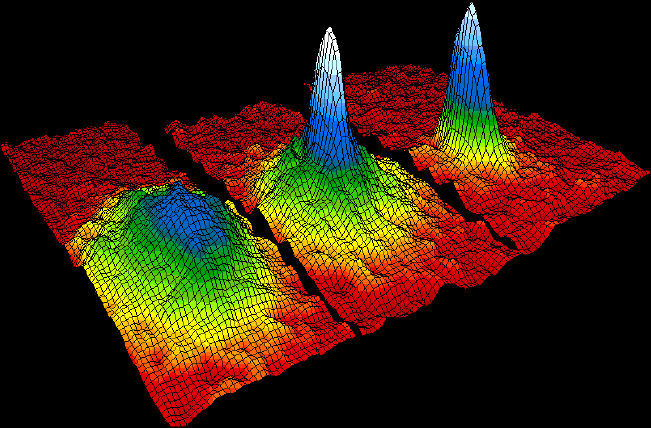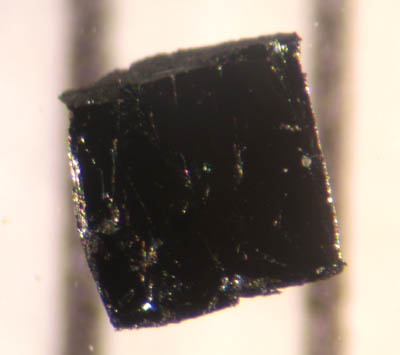|
Superstripes
Superstripes is a generic name for a phase with spatial broken symmetry that favors the onset of superconducting or superfluid quantum order. This scenario emerged in the 1990s when non-homogeneous metallic heterostructures at the atomic limit with a broken spatial symmetry have been found to favor superconductivity. Before a broken spatial symmetry was expected to compete and suppress the superconducting order. The driving mechanism for the amplification of the superconductivity critical temperature in superstripes matter has been proposed to be the shape resonance in the energy gap parameters ∆n that is a type of Fano resonance for coexisting condensates. The superstripes show multigap superconductivity near a 2.5 Lifshitz transition where the renormalization of chemical potential at the metal-to-superconductor transition is not negligeable and the self-consistent solution of the gaps equation is required. The superstripes lattice scenario is made of puddles of multigap supers ... [...More Info...] [...Related Items...] OR: [Wikipedia] [Google] [Baidu] |
Superlattice
A superlattice is a periodic structure of layers of two (or more) materials. Typically, the thickness of one layer is several nanometers. It can also refer to a lower-dimensional structure such as an array of quantum dots or quantum wells. Discovery Superlattices were discovered early in 1925 by Johansson and Linde after the studies on gold–copper and palladium–copper systems through their special X-ray diffraction patterns. Further experimental observations and theoretical modifications on the field were done by Bradley and Jay, Gorsky, Borelius, Dehlinger and Graf, Bragg and Williams and Bethe. Theories were based on the transition of arrangement of atoms in crystal lattices from disordered state to an ordered state. Mechanical properties J.S. Koehler theoretically predicted that by using alternate (nano-)layers of materials with high and low elastic constants, shearing resistance is improved by up to 100 times as the Frank–Read Source, Frank–Read source of dislo ... [...More Info...] [...Related Items...] OR: [Wikipedia] [Google] [Baidu] |
Shape Resonance
In quantum mechanics, a shape resonance is a metastable state in which an electron is trapped due to the shape of a potential barrier. Altunata describes a state as being a shape resonance if, "the internal state of the system remains unchanged upon disintegration of the quasi- bound level." A more general discussion of resonances and their taxonomies in molecular system can be found in the review article by Schulz; for the discovery of the Fano resonance line-shape and for the Majorana pioneering work in this field by Antonio Bianconi; and for a mathematical review by Combes et al. Quantum mechanics In quantum mechanics, a shape resonance, in contrast to a Feshbach resonance, is a resonance which is not turned into a bound state if the coupling between some degrees of freedom and the degrees of freedom associated to the fragmentation (reaction coordinates) are set to zero. More simply, the shape resonance total energy is more than the separated fragment energy. Practical impli ... [...More Info...] [...Related Items...] OR: [Wikipedia] [Google] [Baidu] |
Superconducting
Superconductivity is a set of physical properties observed in superconductors: materials where electrical resistance vanishes and magnetic fields are expelled from the material. Unlike an ordinary metallic conductor, whose resistance decreases gradually as its temperature is lowered, even down to near absolute zero, a superconductor has a characteristic critical temperature below which the resistance drops abruptly to zero. An electric current through a loop of superconducting wire can persist indefinitely with no power source. The superconductivity phenomenon was discovered in 1911 by Dutch physicist Heike Kamerlingh Onnes. Like ferromagnetism and atomic spectral lines, superconductivity is a phenomenon which can only be explained by quantum mechanics. It is characterized by the Meissner effect, the complete cancellation of the magnetic field in the interior of the superconductor during its transitions into the superconducting state. The occurrence of the Meissner effect indica ... [...More Info...] [...Related Items...] OR: [Wikipedia] [Google] [Baidu] |
Feshbach–Fano Partitioning
In quantum mechanics, and in particular in scattering theory, the Feshbach–Fano method, named after Herman Feshbach and Ugo Fano, separates (partitions) the resonant and the background components of the wave function and therefore of the associated quantities like cross sections or phase shift. This approach allows us to define rigorously the concept of resonance in quantum mechanics. In general, the partitioning formalism is based on the definition of two complementary projectors ''P'' and ''Q'' such that :''P'' + ''Q'' = 1. The subspaces onto which ''P'' and ''Q'' project are sets of states obeying the continuum and the bound state boundary conditions respectively. ''P'' and ''Q'' are interpreted as the projectors on the background and the resonant subspaces respectively. The projectors ''P'' and ''Q'' are not defined within the Feshbach–Fano method. This is its major power as well as its major weakness. On the one hand, this makes the method very general and, on the othe ... [...More Info...] [...Related Items...] OR: [Wikipedia] [Google] [Baidu] |
Bose–Einstein Condensate
In condensed matter physics, a Bose–Einstein condensate (BEC) is a state of matter that is typically formed when a gas of bosons at very low Density, densities is cooled to temperatures very close to absolute zero#Relation with Bose–Einstein condensate, absolute zero, i.e. . Under such conditions, a large fraction of bosons occupy the lowest quantum state, at which microscopic Quantum mechanics, quantum-mechanical phenomena, particularly wave interference#Quantum interference, wavefunction interference, become apparent Macroscopic quantum phenomena, macroscopically. More generally, condensation refers to the appearance of macroscopic occupation of one or several states: for example, in BCS theory, a superconductor is a condensate of Cooper pairs. As such, condensation can be associated with phase transition, and the macroscopic occupation of the state is the order parameter. Bose–Einstein condensate was first predicted, generally, in 1924–1925 by Albert Einstein, credit ... [...More Info...] [...Related Items...] OR: [Wikipedia] [Google] [Baidu] |
Spin Orbit Coupling Dispersion Relation
Spin or spinning most often refers to: * Spin (physics) or particle spin, a fundamental property of elementary particles * Spin quantum number, a number which defines the value of a particle's spin * Spinning (textiles), the creation of yarn or thread by twisting fibers together, traditionally by hand spinning * Spin (geometry), the rotation of an object around an internal axis * Spin (propaganda), an intentionally biased portrayal of something Spin, spinning or spinnin may also refer to: Physics and mathematics * Spin group, Spin(''n''), a particular double cover of the special orthogonal group SO(''n'') ** the corresponding spin algebra, \mathfrak(n) * Spin tensor, a tensor quantity for describing spinning motion in special relativity and general relativity * Spin (aerodynamics), autorotation of an aerodynamically stalled aeroplane * SPIN bibliographic database, an indexing and abstracting service focusing on physics research Textile arts * Spinning (polymers), a process f ... [...More Info...] [...Related Items...] OR: [Wikipedia] [Google] [Baidu] |
Strain Engineering
Strain engineering refers to a general strategy employed in semiconductor manufacturing to enhance device performance. Performance benefits are achieved by modulating strain, as one example, in the transistor channel, which enhances electron mobility (or hole mobility) and thereby conductivity through the channel. Another example are semiconductor photocatalysts strain-engineered for more effective use of sunlight. In CMOS manufacturing The use of various strain engineering techniques has been reported by many prominent microprocessor manufacturers, including AMD, IBM, and Intel, primarily with regards to sub-130 nm technologies. One key consideration in using strain engineering in CMOS technologies is that PMOS and NMOS respond differently to different types of strain. Specifically, PMOS performance is best served by applying compressive strain to the channel, whereas NMOS receives benefit from tensile strain. Many approaches to strain engineering induce strain locally, al ... [...More Info...] [...Related Items...] OR: [Wikipedia] [Google] [Baidu] |
Intercalation (chemistry)
Intercalation is the reversible inclusion or insertion of a molecule (or ion) into layered materials with layered structures. Examples are found in graphite and transition metal dichalcogenides. : Examples Graphite One famous intercalation host is graphite, which intercalates potassium as a guest. Intercalation expands the van der Waals gap between sheets, which requires energy. Usually this energy is supplied by charge transfer between the guest and the host solid, i.e., redox. Two potassium graphite compounds are KC8 and KC24. Carbon fluorides (e.g., (CF)x and (C4F)) are prepared by reaction of fluorine with graphitic carbon. The color is greyish, white, or yellow. The bond between the carbon and fluorine atoms is covalent, thus fluorine is not intercalated. Such materials have been considered as a cathode in various lithium batteries. Treating graphite with strong acids in the presence of oxidizing agents causes the graphite to oxidise. Graphite bisulfate, 24sup>+ SO4sup ... [...More Info...] [...Related Items...] OR: [Wikipedia] [Google] [Baidu] |
La2CuO4 Structure
LA most frequently refers to Los Angeles, the second most populous city in the United States of America. La, LA, or L.A. may also refer to: Arts and entertainment Music *La (musical note), or A, the sixth note *"L.A.", a song by Elliott Smith on ''Figure 8'' (album) * ''L.A.'' (EP), by Teddy Thompson *''L.A. (Light Album)'', a Beach Boys album * "L.A." (Neil Young song), 1973 *The La's, an English rock band *L.A. Reid, a prominent music producer *Yung L.A., a rapper *Lady A, an American country music trio * "L.A." (Amy Macdonald song), 2007 *"La", a song by Australian-Israeli singer-songwriter Old Man River *''La'', a Les Gordon album Other media * l(a, a poem by E. E. Cummings *La (Tarzan), fictional queen of the lost city of Opar (Tarzan) *''Lá'', later known as Lá Nua, an Irish language newspaper *La7, an Italian television channel *LucasArts, an American video game developer and publisher * Liber Annuus, academic journal Business, organizations, and government agenc ... [...More Info...] [...Related Items...] OR: [Wikipedia] [Google] [Baidu] |
High-temperature Superconductivity
High-temperature superconductivity (high-c or HTS) is superconductivity in materials with a critical temperature (the temperature below which the material behaves as a superconductor) above , the boiling point of liquid nitrogen. They are "high-temperature" only relative to previously known superconductors, which function only closer to absolute zero. The first high-temperature superconductor was discovered in 1986 by IBM researchers Georg Bednorz and K. Alex Müller. Although the critical temperature is around , this material was modified by Ching-Wu Chu to make the first high-temperature superconductor with critical temperature . Bednorz and Müller were awarded the Nobel Prize in Physics in 1987 "for their important break-through in the discovery of superconductivity in ceramic materials". Most high-c materials are type-II superconductors. The major advantage of high-temperature superconductors is that they can be cooled using liquid nitrogen, in contrast to previously known s ... [...More Info...] [...Related Items...] OR: [Wikipedia] [Google] [Baidu] |
Superfluid
Superfluidity is the characteristic property of a fluid with zero viscosity which therefore flows without any loss of kinetic energy. When stirred, a superfluid forms vortex, vortices that continue to rotate indefinitely. Superfluidity occurs in two isotopes of helium (helium-3 and helium-4) when they are liquefied by cooling to cryogenic temperatures. It is also a property of various other exotic State of matter, states of matter theorized to exist in astrophysics, high-energy physics, and theories of quantum gravity. The theory of superfluidity was developed by Soviet theoretical physicists Lev Landau and Isaak Khalatnikov. Superfluidity often co-occurs with Bose–Einstein condensate, Bose–Einstein condensation, but neither phenomenon is directly related to the other; not all Bose–Einstein condensates can be regarded as superfluids, and not all superfluids are Bose–Einstein condensates. Even when superfluidity and condensation co-occur, their magnitudes are not linked: ... [...More Info...] [...Related Items...] OR: [Wikipedia] [Google] [Baidu] |



